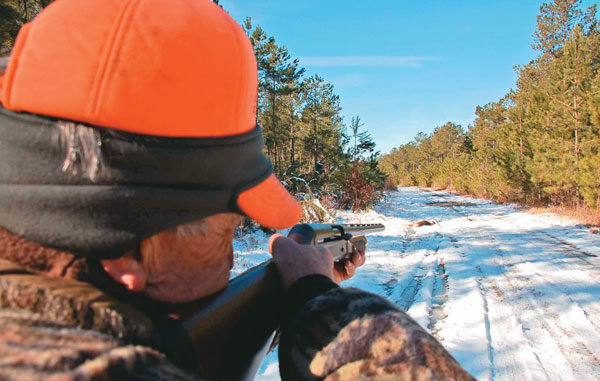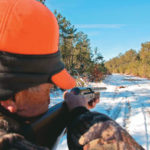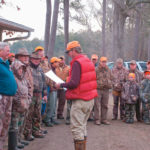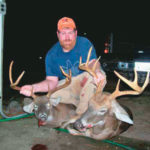
A southern deer-hunting tradition warms up on storied club lands as cooler autumn air invades the coastal plane.
As autumn settles across the Tarheel State, practitioners of a century-old tradition begin to stir. In an age when technological advances have changed the dynamics of deer hunting across the nation, the “Dixie” deer hunt — driving deer with dogs is the name of the game — has changed very little from its historical roots in the rural eastern third of North Carolina.
The familiar melody of hounds on a cool autumn day is recognized by many who love the chase and its music. The timeless tradition, which dates to colonial times, fills the hearts of many outdoorsmen with joy.
Hunting deer with dogs is deeply rooted in the south, but George Clark, huntmaster of the second-oldest deer hunting club in the state, the North State Game Club, is particular about the description of his sport.
“While a few dogs may slip up and run deer from time to time, we run deer with hounds here at North State, not dogs,” he said.
Hounds may actually be dogs, but they have unique traits that enable to them to trail and chase their quarry, by scent or by sight. In fact, North Carolina annointed the Plott hound as the official state dog in 1989. While Plott hounds are better known for their bear-hunting and hog-hunting exploits, many deer hunters use them and other members of the hound family to flush and push whitetails toward standers waiting with visions of venison steaks on the brain.
Clark spends most weekends during the gun season on North State Game Club’s lands in Bladen and Columbus Counties. He guides packs of tail-wagging canines into dense bramble thickets, flushing bedded deer and pushing them onto familiar paths. His hounds follow along, accelerating as they locate and recognize the sweet essence left behind on leaves and debris on the forest floor. Even the most-prepared hunter on stand, clothed in a mixture of blaze orange and camouflage, will feel a shudder when crunching leaves and pitter-patter on the forest floor predict an approaching target.
Robert “Coke” Gray III, a native of Columbus County, began hunting at North State at an early age. While he still-hunts throughout the season, he loves the fellowship and unique traits of the scheduled hunts with hounds, eagerly awaiting the opportunity to let his ears soak up the harmonious tunes of the club’s prized hounds as they close in on their fleeing prey.
“Hunting with hounds at North State, I hold dear to my heart. Participating in the hunts with family and friends is just a real special time before, during, and after the hunt,” he said.
For nearly three decades, Gray has practiced safe and effective dog-driving methods on North State’s land, killing many exceptional bucks. The majority of the club continues to hunt the same parcels of land that were hunted early in the 20th century. Since the majority of the club’s hunting leases fall under forest industry ownership, intense timber management practices keep them in a constant state of succession from clear-cut to 30- and 40-year old plantations. In addition to piney woods, small, braided stream swamps and Carolina Bays make up a significant portion of the land.
Hunting methods have changed little since North State’s inception. The club organizes its hunters at daybreak to get a head count, and a hunt plan is prepared over a generous portion of scrambled eggs, grits, thick-sliced bacon and pot of hot coffee. Organizers choose the land to be hunted that day and develop a hunt plan that includes boundaries, stander coverage and dog insertions points.
Not only do club members want to harvest big bucks, the club prepares venison meals three days per week for the membership, and hunt plans must be developed to stock the cooler and keep the cooks happy with both bucks and does. When Clark works on the plan for a morning’s hunt, he bases it on the number of hunters, recent activity and the heaviest concentration of deer sign throughout the property. Fortunately, the rut will concentrate bucks in areas where does are plentiful, near concentrated food sources and heavy cover. While North State takes advantage of a few food plots scattered across its leases, it supplements the herd’s natural food availability with corn and sweet potatoes.
Successful dog-driving operations must include a combination of good hounds and strategic hunter coverage within an ideal location abundant with deer. Choosing the limits of the hunting area with the number of hunters is a delicate decision to ensure good coverage and maintain safe hunting conditions.
Even under pressure from approaching hounds, fleeing deer will maintain their routine travel routes.
“The areas we hunt have been hunted for generations, and there are known traditional crossings,” Gray said. “Although we concentrate on placing hunters around the perimeter of the hunt and throughout the interior of the hunt along ditches and fire lanes, there are key crossings we make a point to cover.”
In 2010, North State erected markers on all its interior roads to place standers. Marker placement was developed based on essential coverage, traditional deer passages and safety concerns. North State practices and maintains high safety standards to allow for an enjoyable and safe hunt for its members and invited guests.
In addition to hunter coverage, hound placement and the number of hounds unleashed have a direct impact on hunting success. The variable terrain of southeastern North Carolina will have no shortage of thick cover and water. Deer will bed and travel within key areas throughout their home range between food, cover and water. According to Gray, North State releases its hounds around known bedding areas, frequented food sources and travel ways with fresh deer sign. Released hounds are always accompanied by drivers that walk through the woods hollering and calling the dogs in hopes of rising deer from their beds.
Joey Nicoll, a native of Robeson County, believes in using a large number of dogs on his hunts at Simmons Bay Hunting Club on the outer edge of Columbus County’s infamous Green Swamp, which has lots of places for deer to hide and evade his sights. For more than three decades, Nicoll has participated in dog driving and has a real dedication to the sport.
Simmons Bay covers around 5,300 acres, but hunts will cover areas of between 500 and 1,000 acres at a time, depending on the number of hunters and the available dogs.
“On biggest hunts are on Saturdays,” Nicoll said. “We will incorporate 10 to 15 packs of dogs (usually 75 to 100 dogs) into our hunt. We usually release all of our dogs within strategic areas to flush deer out of hiding and to keep them on the move.”
Deer will sometimes remain bedded when only a few dogs are in the area. Nicoll believes that increasing the number of dogs used on each hunt forces deer to get up and move down traditional travel paths.
Not only is a strategic plan required, killing deer — especially big bucks — during a dog drive requires stander responsibility. Generally, hounds will jump a deer or group of deer and will run them throughout the hunting block or across roads to other areas. During the commotion, other deer will attempt to slip away from the pandemonium, using traditional travel passages to get away from the hunt. In fact, mature bucks in areas where dogs are used become acclimated to the scheme and will often be the first to slip away when the first few yelps are heard. Conversely, some big bucks will stay put in deep cover, hoping the drivers and dogs will pass by, allowing them to slip out later in the day.
“On any hunt, our hunters have the chance to encounter a huge buck at any time,” Gray said. “Hunters should remain alert at all times during the entire hunt.”
Pursued by hounds, deer will travel in different ways depending on the wind direction and the maturity of the animal. Their sense of small is a most-valuable asset while being chased through the wilderness; running into the wind allows their noses to pick out possible danger, thereby directing their choices of escape.
“Mature deer are extremely smart, fast, and cautious,” Gray said. “A mature deer tends to run parallel to a road and into the wind. If they do not like a certain crossing, they may circle the block several times before finding an acceptable place to cross.”
Finding and running big, mature bucks can be a difficult task, especially with deer gravitating toward water.
“Big bucks, basically, are educated from years of escaping and avoiding dangerous encounters with hunters, and bucks will use water to shake a pack of dogs very easily,” Nicoll said.
When hunts are being planned at Simmons Bay, Nicoll and others make a point to cover historic crossing areas near or in flooded areas of their lease.
Hunting with hounds can be a very rewarding experience. Hunting clubs such as North State and Simmons Bay carry on the timeless tradition of the Dixie deer hunt. In addition to the venison packed into the freezer and the trophy bucks delivered to the taxidermist, the traditional Dixie deer hunt generates priceless fellowship and lasting memories.







Be the first to comment